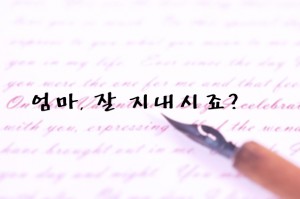한국어 Sentence Structures
The basic structures in Korean are “Subject+predicate” or “Subject+Object+Predicate.” There is a space between the subject, object, and the predicate, and sentences end with a period.
원빈오빠가subject 가요predicate. Won Bin oppa goes.
애슐리가subject 커피를object 마셔요 predicate. Ashley drinks coffee.
In Korean, a noun and subject marker(i.e.이/가) are placed together to indicate the subject of a sentence, and a noun and object marker (i.e. 을/를) are placed together to represent the object.
원빈오빠+가 가요 -> 원빈오빠가 가요.
애슐리+가 커피+를 마셔요. -> 애슐리가 커피를 마셔요.
멍멍이가 있어요. There is a puppy.
애슐리가 책을 읽어요 Ashley reads a book.
원빈오빠가 밥을 먹어요. WonBin oppa eats meals.
In Korean, the predicate of a sentence is comprised of a verb and adjective. The stems of the verbs and adjectives are conjugated to indicate the past, present, and future tenses.
basic/dictionary form 가다 to go 읽다 to read
Present form 가요 읽어요
Past tense 갔어요 읽었어요
Future tense 갈 거예요/ 가겠어요 읽을 거예요/ 읽겠어요
In the above examples, 가다 and 읽다 are the basic forms of the verbs. From these, -어요/ -었/-을 거예요 or –겠are used to conjugate the verb and represent different tenses.
원빈오빠가 책을 읽다. WonBin oppa reads a book.
원빈 오빠가 책을 읽어요. WonBin oppa reads a book.
원빈 오빠가 책을 읽었어요. WonBin oppa read a book.
원빈 오빠가 책을 읽을 거예요/ 책을 읽겠습니다. WonBin oppa is going to read a book.ac
Reference
Cho, H. R. & Lee, J.Y. (2008). Practical Korean Basic 1. Seoul : Darakwon.
Written by Eun Kyeong Ashley Jang (Korean teacher)




Latest Comments